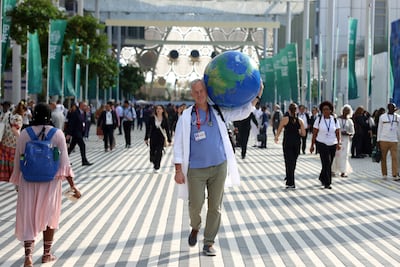Live updates: Follow the latest news on Cop28
It is “fast becoming inevitable” that global warming will exceed the key target of 1.5°C above pre-industrial levels and leave the world trying to claw it back down, the Cop28 summit has been told.
Scientists say the world will have to reckon with 1.5°C-plus for “at least some decades”, in what is known as an overshoot.
It would then have to turn the heat back down, using trees and carbon capture to replace “net zero” with “net negative” – or else turn to some sci-fi geoengineering.
This has long been regarded as “Plan B” but is becoming Plan A because emissions have not been cut fast enough to stay on track, said Dr Oliver Geden, an author of the findings unveiled in the UAE.
Even if temperatures eventually fall back to 1.5°C above pre-industrial levels, some effects will be irreversible such as extinct species that “won’t come back”, he said.
“We know we’re likely going to cross it, and we should prepare for it. But we also should prepare the decision of what to do about it, and not just say that fight is lost,” Dr Geden told The National.
The Paris Agreement calls for global warming to be held to 1.5°C above pre-industrial levels but does not set a specific deadline, although scientists advising the UN have made calculations up to 2100.
Johan Rockstrom, director of the Potsdam Institute for Climate Impact Research, said there was a one in two chance of returning to 1.5°C above pre-industrial levels by the end of the century, according to the research presented to the UN's climate body.
Many countries are aiming for net zero emissions by 2050 but temperatures could keep rising anyway because carbon dioxide lingers in the atmosphere for hundreds of years.
That means the world needs to get more comfortable talking about carbon removal, said Dr Geden, a subject which campaigners have often viewed with suspicion because they fear it is used to kick emission cuts into the long grass.
“If you want to return warming to an earlier level like 1.5°C, then you would have to get net negative CO2 [carbon dioxide] emissions, or more removals than emissions,” he said.

“Even [if] it would stabilise at 1.5°C, sea level rise would still be there for centuries, so even 1.5°C is not that kind of safe level where everything is fine. Species extinction – if they are gone, they won’t come back. You could see forested areas getting out of balance.
“Since it was always seen as a Plan B and ‘let’s not talk about it too much’, this is really an area where more research needs to be done.”
The 10 New Insights in Climate Science report says there are “multiple lines of evidence” suggesting it is no longer possible to stop the temperature juggernaut at 1.5°C without an overshoot.
It warns of a vicious cycle in which, for example, a long period above 1.5°C damages the Earth’s natural carbon sinks and means global warming only causes more global warming.
“Overshooting 1.5°C is fast becoming inevitable. Minimising the magnitude and duration of overshoot is essential,” the report says.
Green Zone at Cop28 opens to public - in pictures

























“No pathway remains that avoids exceeding 1.5°C global warming for at least some decades, except for truly radical transformations.”
Most carbon removal today involves trees, although more technical options are being developed in which carbon dioxide is sucked out of the atmosphere and buried underground or in the sea.
Such technology will take “a long time to become mature”, said Dr Geden, and is described in a UN report underpinning Cop28’s global stocktake as having a range of practical issues.
Then there is what he called the “real scary stuff”, such as radical proposals to divert sunlight into space, known as solar radiation modification.
For carbon removal to be given a chance instead, policies “must be put in place in the near term”, the findings say – with the stocktake regarded as a key chance to take action before the next one is due in 2028.


